jamesp
Cave Dweller 
Member since October 2012
Posts: 36,607
|
Post by jamesp on Jul 15, 2014 7:01:04 GMT -5
This is one of four bone I found shaped like this. Some with a steeper angle. Apparently it is the rim of the ancient tortoise shell, a 6 footer at about 600 pounds. "Due to the moderate climate during the warm phase of the Ice Age or Pleistocene Period, they did well in Florida, but became extinct later. The fossil record suggests that early prehistoric people (Paleo-Indians), of Florida, lived here with the giant beasts and hunted them for food." 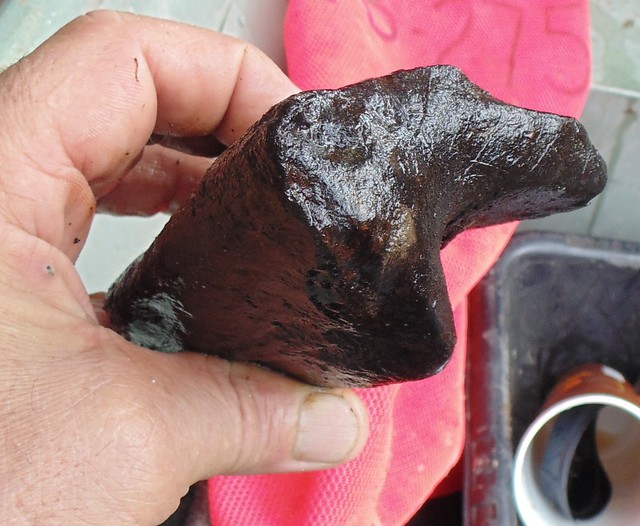 |
|
Fossilman
Cave Dweller 
Member since January 2009
Posts: 20,723 
|
Post by Fossilman on Jul 15, 2014 8:33:27 GMT -5
WOW!!! How cool is that!!!
|
|
jamesp
Cave Dweller 
Member since October 2012
Posts: 36,607
|
Post by jamesp on Jul 15, 2014 8:44:28 GMT -5
WOW!!! How cool is that!!! Turtle soup galore Michael. Need to go back and get the rest of him. Bones were together in calm spot of river. I find buckets of scutes in Lake George of modern turtles. And the Gopher Tortoise is common in Florida; and will send you to jail if you make soup out of him. |
|
jamesp
Cave Dweller 
Member since October 2012
Posts: 36,607
|
Post by jamesp on Jul 15, 2014 8:47:43 GMT -5
Beware of large snappers 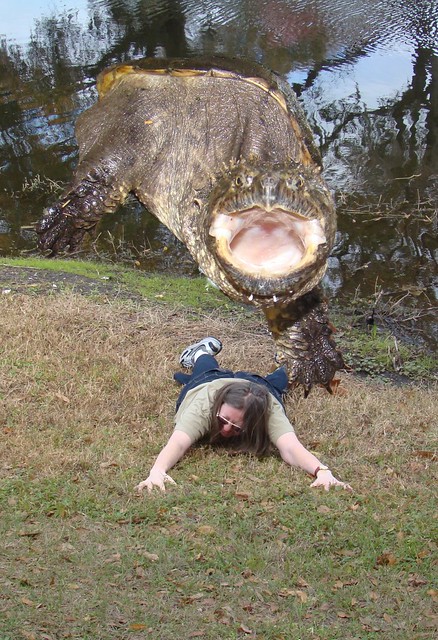 |
|
Deleted
Deleted Member
Member since January 1970
Posts: 0
|
Post by Deleted on Jul 15, 2014 12:37:58 GMT -5
Yes, this is very interesting.
This because we have all been taught that the giant tortoises of say the Galapagos or Aldabra Island are what is called "insular gigantism". That is; a tortoise species that evolved to a large size as a way to survive on small islands.
But here we learn that mainland tortoises were giant too. In fact, the ancestral form for tortoises are all giant. Therefore the smaller mainland tortoises are due to a result of continental dwarfism, the exact opposite of what we have been taught for centuries.
Love that bone!!
|
|
jamesp
Cave Dweller 
Member since October 2012
Posts: 36,607
|
Post by jamesp on Jul 15, 2014 17:22:08 GMT -5
Yes, this is very interesting. This because we have all been taught that the giant tortoises of say the Galapagos or Aldabra Island are what is called "insular gigantism". That is; a tortoise species that evolved to a large size as a way to survive on small islands. But here we learn that mainland tortoises were giant too. In fact, the ancestral form for tortoises are all giant. Therefore the smaller mainland tortoises are due to a result of continental dwarfism, the exact opposite of what we have been taught for centuries. Love that bone!! Apparently the tortoise from the pliocene is the same size as Galapagos tortoises. I thought they might be much bigger. |
|
|
|
Post by snowmom on Jul 15, 2014 18:23:10 GMT -5
cool. now we need our resident reptile expert to post a turtle skeleton so we can locate the bones in question.
Sometimes this sort of thing raises more questions than those answered (so much fun!)
|
|
Deleted
Deleted Member
Member since January 1970
Posts: 0
|
Post by Deleted on Jul 15, 2014 19:40:22 GMT -5
couldnt find a tortoise. here is an even larger sea turtle 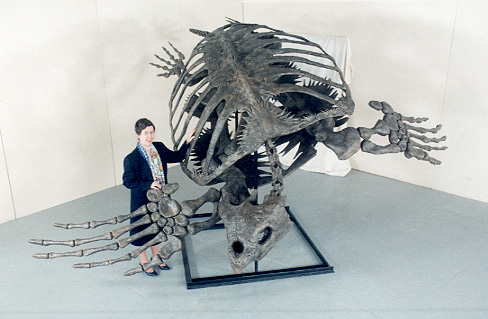 I am going to guess that this is more like what you have as the shell of a tortoise is completely bony. |
|
jamesp
Cave Dweller 
Member since October 2012
Posts: 36,607
|
Post by jamesp on Jul 15, 2014 19:52:15 GMT -5
They bring home a lot of scutes(shell sections). I think they are from full shelled turtles. Scutes about the most common bone found.
that turtle is incredible.
|
|
Deleted
Deleted Member
Member since January 1970
Posts: 0
|
Post by Deleted on Jul 15, 2014 21:31:41 GMT -5
Scutes are made of fingernail [keratin], and thus no fossil. The skeleton does not match the scutes, rather, they are layered, like brickwork; for strength.  I don't see a bone similar to yours on a tortoise. I been wrong before. Prolly wrong now! |
|
jamesp
Cave Dweller 
Member since October 2012
Posts: 36,607
|
Post by jamesp on Jul 15, 2014 21:42:19 GMT -5
The scutes cover the bones of the shell like fingernails. it is true. but scutes = bones under them. The bone they described are the opening 'trim' bone, a wedge. Open on the shell side and wedge shaped on the rim side. Here are fossilized scutes for sale. they are common. texasrockshop.com/fossils/vertebrates/turtle/fo_turtle_thumb02.html |
|
Fossilman
Cave Dweller 
Member since January 2009
Posts: 20,723 
|
Post by Fossilman on Jul 16, 2014 9:35:23 GMT -5
Super find James,super find...
|
|
Deleted
Deleted Member
Member since January 1970
Posts: 0
|
Post by Deleted on Jul 16, 2014 10:19:53 GMT -5
The link you supply is mis-naming the pieces he has. Those are not scutes. They are bones.  The three lines on this hypoplastron bone are the edges of the scutes layerd on the outside of the turtle. Here are the names for the bones of a tortoise. I guess your long narrow narrow wedge shaped piece is the marginal plate.  |
|
jamesp
Cave Dweller 
Member since October 2012
Posts: 36,607
|
Post by jamesp on Jul 17, 2014 6:27:41 GMT -5
I never looked up the bones that surround the shell. Marginal bone is what they say that bone is. I found the definition of scute loose. I did look that one up because it is used so much in the fossil community. Websters defined it as "an external bony or horny plate or large scale". So it may sneak by on Webster's radar. And I always thought that turtle shell jewelry was always made out of the scutes(the finger nail like colored plates that cover the bone). The paleontologists refer to the shell sections of a turtle as scutes: Pseudemys williamsi is a member of the family Emydidae, which includes the pond and box turtles. Pseudemys williamsi can be distinguished from other similar taxa based on three characteristics. Pseudemys williamsi is smooth-shelled (Fig. 2) unlike the rugose shell of other taxa such as Pseudemys caeleta, and species of Trachemys and Deirochelys. Additionally, Pseudemys williamsi has a short nuchal scute (also commonly referred to as the cervical scute) underlap (Fig. 3) and short gular scute overlap on the epiplastron (Fig. 4). Pseudemys williamsi shares these characteristics with the modern river cooter, Pseudemys concinna. However, the nuchal of Pseudemys concinna is notched and more trapezoidal in shape and the posterior peripherals are slightly notched. The short nuchal underlap and gular overlap can also be used to distinguish Pseudemys williamsi from other emydids such as Pseudemys caeleta, Pseudemys floridana, and species in the Trachemys scripta complex (Rose and Weaver, 1966). Pseudemys williamsi usually co-occurs with other emydid taxa at the localities where it is found, such as Pseudemys caeleta.  |
|
|
|
Post by Peruano on Jul 17, 2014 15:59:55 GMT -5
James, The describer of the fossil turtle you are quoting is talking about the shape of the scutes (the keratinized outer covering of the carapace (shell), by looking at the grooves left in the boney carapace by the scutes that are no longer present. Much like looking at foot prints in mud or water rings left on your wife's coffee table by your martini glass.
A scute is the epidermal covering of most turtle shells. Indeed tortoise shell jewelry is made from the scutes of the hawksbill turtle. Tortoise shell like your grandmom's hair comb was made out of was keratin, not bone. Now cheap plastic substitutes are just as pretty (note your neighbor's glasses).
We should note that your "presumed" turtle bone has no relation to your Pseudemys (Trachemys) mentioned in your last post to illustrate the use of the words scute. I worked with turtles, but am no expert on fossils other than from an anatomical sense. Cheers and keep on diving for those specimens. Tom
|
|
jamesp
Cave Dweller 
Member since October 2012
Posts: 36,607
|
Post by jamesp on Jul 17, 2014 21:08:26 GMT -5
James, The describer of the fossil turtle you are quoting is talking about the shape of the scutes (the keratinized outer covering of the carapace (shell), by looking at the grooves left in the boney carapace by the scutes that are no longer present. Much like looking at foot prints in mud or water rings left on your wife's coffee table by your martini glass. A scute is the epidermal covering of most turtle shells. Indeed tortoise shell jewelry is made from the scutes of the hawksbill turtle. Tortoise shell like your grandmom's hair comb was made out of was keratin, not bone. Now cheap plastic substitutes are just as pretty (note your neighbor's glasses). We should note that your "presumed" turtle bone has no relation to your Pseudemys (Trachemys) mentioned in your last post to illustrate the use of the words scute. I worked with turtles, but am no expert on fossils other than from an anatomical sense. Cheers and keep on diving for those specimens. Tom It is good to be scutinized, I mean scrutinized from time to time. In fossil discussions they use scute. I wonder why. Especially when referring to alligators and turtles. The word osteoderm is the bone associated to the scute I suppose. I am not going to tell them. They dig deep holes and can be ornery. Thanks for the correction. Speaking of scales/scutes, these were biting well today. About every cast a fish was on. Bluegill  Hybrid, Red Belly mixed with I can not remember, note the long ear 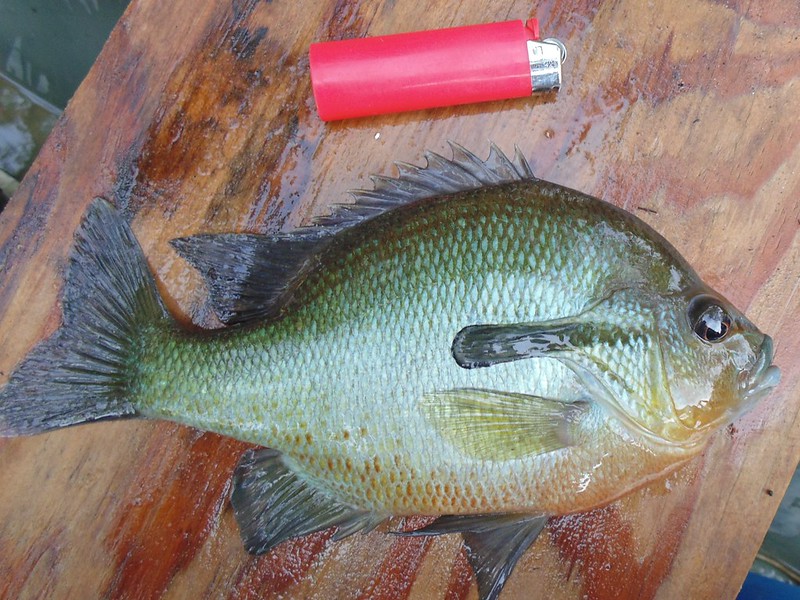 No scales on this one, channel cat ?? 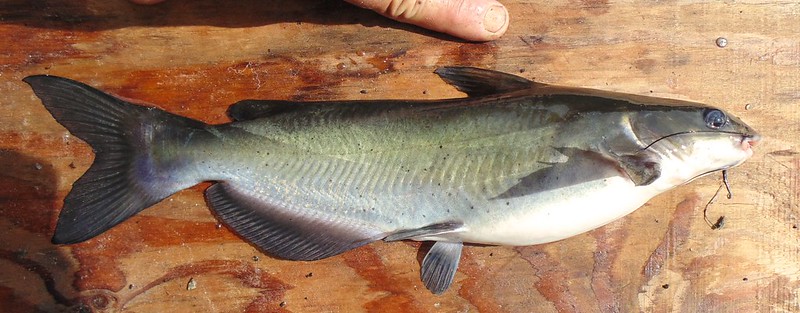 The monster 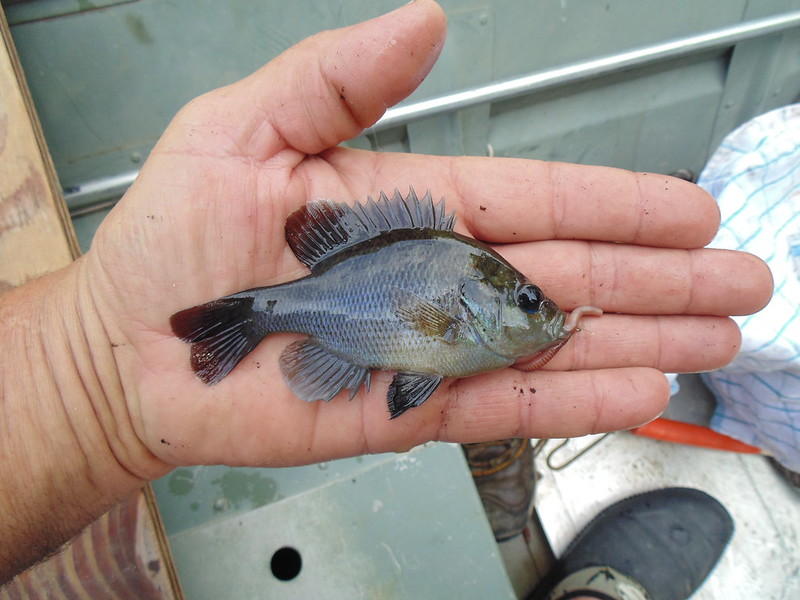 |
|
quartz
Cave Dweller  breakin' rocks in the hot sun
breakin' rocks in the hot sun
Member since February 2010
Posts: 3,359
|
Post by quartz on Jul 17, 2014 21:37:39 GMT -5
Ah, bluegills, used to catch many in the creek behind the house in the fall. Froze them in half-gallon milk containers and used them for fertilizer under tomatoes and corn the next spring. Worked great.
|
|
jamesp
Cave Dweller 
Member since October 2012
Posts: 36,607
|
Post by jamesp on Jul 17, 2014 22:07:44 GMT -5
Ah, bluegills, used to catch many in the creek behind the house in the fall. Froze them in half-gallon milk containers and used them for fertilizer under tomatoes and corn the next spring. Worked great. I now know that if I get stranded on that river I can eat like a king. Fish is a great fertilizer. I believe the natives used it for their corn. |
|
quartz
Cave Dweller  breakin' rocks in the hot sun
breakin' rocks in the hot sun
Member since February 2010
Posts: 3,359
|
Post by quartz on Jul 18, 2014 0:19:39 GMT -5
Not only will the bluegill supply protein, you get lots of toothpicks too. Fish in general are pretty good eating.
|
|
jamesp
Cave Dweller 
Member since October 2012
Posts: 36,607
|
Post by jamesp on Jul 18, 2014 6:31:49 GMT -5
Not only will the bluegill supply protein, you get lots of toothpicks too. Fish in general are pretty good eating. They are full of bones. And small to filet. My cousin cooks them with the skin on. Using a batter that allows you to split the fish along the back bone. And remove the meat from the skin. The batter holds the bones in place if you are careful. |
|
























